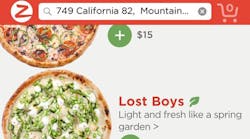In the back kitchen of the newest pizzeria in Mountain View, California, Marta works tirelessly, spreading marinara sauce on uncooked pies. She doesn’t complain, takes no breaks, and has never needed a sick day. She works for free.
Marta is one of two robots working at Zume Pizza, a secretive food delivery startup trying to make a more profitable pizza through machines. It’s also created special delivery trucks that will finish cooking pizzas during the journey to hungry customers if approved by the Santa Clara County Department of Environmental Health. Right now, Zume is only feeding people in Mountain View, but it has ambitions to dominate the $9.7 billion pizza delivery industry.
“We are going to be the Amazon of food,” said Zume’s co-founder and executive chairman, Alex Garden. Garden, 41, is the former president of Zynga Studios. Before that, he was a general manager of Microsoft’s Xbox Live. Garden launched Zume in stealth mode last June, when he began quietly recruiting engineers under a pseudonym and building his patented trucks in an unmarked Mountain View garage.
In September, he brought on Julia Collins, a 37-year-old restaurant veteran. She became CEO and a co-founder. Collins was previously the vice president and CEO of Harlem Jazz Enterprises, the holding company for Minton’s, a historic Harlem eatery. In October, Zume began working closely with Swiss robot maker, ABB, and a global crew of mechanical, electrical and software engineers. In April, the startup sold its first cyborg-constructed pie to an unsuspecting customer in Mountain View.
People familiar with Zume’s fundraising discussions said that Google Ventures, as well as Kleiner Perkins Caufield & Byers are considering Series A bids. In May, Yahoo Inc. founder Jerry Yang was seen touring the pizzeria with his crew of investors from AME Cloud Ventures. Garden said he didn’t want to talk about fundraising, “But I can tell you the venture community is validating our idea.”
Two minutes from Google’s main campus, Zume’s headquarters sits in an unmarked concrete building that looks like an auto repair shop. The 8,000 square foot interior is divided into a large kitchen, where the robots are; and an office space, where twelve engineers, designers and product managers work. The building also has a machine and fabrication workshop.
Inside Zume’s kitchen, protective glass boxes separate the robots from humans. Marta hangs from the ceiling of her cage like a giant spider, her spindly robot arms converging, ladle-like, to douse a pie with sauce in under two seconds. “We created her to spread your sauce perfectly, but not too perfectly, so the pizza still looks like an artisan product,” Garden said.
Fully sauced, the pie travels on a conveyer belt to human employees who add cheese and toppings. The decorated pies are then scooped off the belt by a 5-foot tall grey automaton, Bruno, who places each in an 850-degree oven. For now, the pizzas are fully cooked and delivered to customers in branded Fiats painted with slogans, including: “You want a piece of this?” and “Not part of the sharing economy.”
Now Cooking: A Mobile Kitchen
In August, Zume wants to start cooking its pizzas in the startup’s patented delivery trucks. Each truck has 56 ovens that can be turned on and off remotely. Garden can barely contain his excitement for what comes next: “The robots will load all these individual ovens with different menu items. Then the truck will circle the neighborhood. At precisely 3 minutes and 15 seconds before arriving at the customer’s location, the cloud commands the oven to turn on and” — Garden made the symbol of a large explosion emanating from his brain – “BOOM, the customer gets a fresh, out-the-oven pizza delivered to their door.”
Nobody has ever done this before, he said. The Santa Clara County Health Department is reviewing Zume’s mobile food permit application now, and the startup’s truck plan depends on its approval. Although laws vary from state to state, traditional food trucks generally aren’t allowed to cook food while in motion.
Garden is confident it won’t be long before he’s competing with the major pizza chains. “Just imagine Domino’s without the labor component,” said Garden. “You can start to see how incredibly profitable that can be.”
Yum! Brands Inc.’s Pizza Hut and Domino’s have been experimenting with robots, too. Last month, Pizza Hut Asia partnered with Mastercard and Softbank to develop a robotic cashier, named Pepper, which uses artificial intelligence to interact with customers. The company plans to deploy Pepper in selected outlets across Asia by the end of the year, said Chaiti Sen, a Mastercard spokeswoman. In April, Domino’s Australia began testing an “autonomous delivery vehicle,” named Dru. The 3-foot, four-wheeled machine —it looks like a photocopier on wheels — can make deliveries up to six miles, said a company spokeswoman.
Analysts were quick to raise skepticism about Zume’s grand plans, especially considering that Papa Johns, Domino’s and Pizza Hut account for 58% of the U.S. pizza delivery market. “It’s a very difficult industry,” said Michael Halen, a Bloomberg Intelligence research analyst focused on global restaurant chains. John Glass, an analyst for Morgan Stanley, said that a lack of recognition will make it hard for Zume to compete with bigger names. “The big brands are gaining an incremental market share at the expense of smaller chains and independents,” he said.
For now, Zume is focusing on winning over locals. Adam Martyn, who works at Stanford University, said he treats himself to the Lucky Bueno every two weeks. That’s a spicy pie with roasted garlic, Calabrian chili and soppressata for $18. “The robots are cool,” Martyn said, “but I order because it tastes good.”
By Olivia Zaleski




